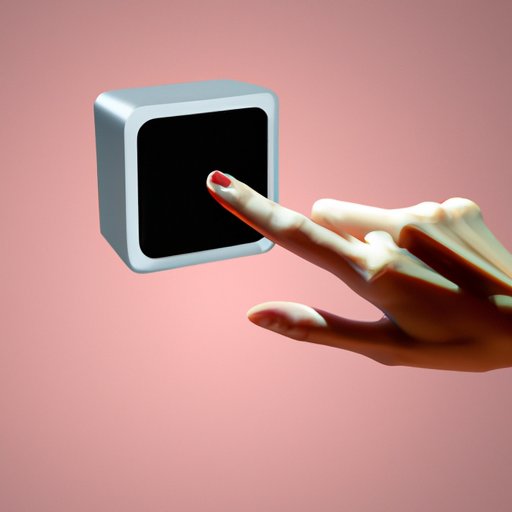Introduction
If you’re holding a smartphone or using a video game controller, chances are you’re already familiar with haptic feedback. Haptic feedback, also known as tactile or touch feedback, is a type of technology that provides users with physical responses to digital interactions. From the small buzz of your phone to the vibrations of a gaming controller, haptic feedback can enhance the user experience by providing another layer of sensory input. In this ultimate guide to haptic feedback, we’ll explore the different aspects of this technology, discussing everything from how it works to its benefits.
A Beginner’s Guide to Haptic Feedback: Exploring the World of Tactile Response
Haptic feedback uses various touch technologies to provide physical responses to digital interactions. Some examples of touch technology include:
– Vibrations
– Taps or “clicks”
– Pressure changes
– Texture changes
These physical cues are designed to enhance the user experience and provide a more immersive interaction with digital technology. For example, a video game controller may use haptic feedback to provide feedback when a character jumps or when a vehicle crashes.
Haptic feedback works by using motors or other devices to create a physical response when a digital interaction occurs. For example, when you receive a notification on your phone, the device will vibrate, creating a specific pattern to indicate which app or contact sent the notification. This physical response reinforces the digital interaction and provides an additional level of feedback to the user.
Common misconceptions about haptic feedback include that it drains battery life significantly and that it’s only used in specific industries, such as gaming. While it was once true that haptic feedback used a lot of battery power, newer devices and technologies have addressed this issue. Additionally, haptic feedback is being used in an increasingly wide range of industries, including healthcare, automotive, and even marketing.
Haptic Feedback Explained: The Science behind Touch Technology
To truly understand haptic feedback, it’s essential to understand the science behind touch technology. The field of haptics focuses on our sense of touch and how we perceive different tactile inputs.
Haptic feedback can be categorized into two types: vibrotactile and kinesthetic.
Vibrotactile feedback refers to the vibrations or other physical cues created by devices like phones or gaming controllers. A smartphone might use a buzz or vibration to notify users of a new message or email.
Kinesthetic feedback refers to the physical pressure or resistance created by devices like force sensors or resistive touchscreens. When you push a button on a controller or a pressure-sensitive touchscreen, you’re interacting with kinesthetic feedback.
The technology behind haptic feedback works by using different forces to create a physical response. Devices like phones or gaming controllers use small motors to create a vibration or buzz, while force sensors in touchscreen devices use pressure to create a response.
How Haptic Feedback is Revolutionizing the Way We Interact with Our Devices
Haptic feedback has come a long way in recent years, and it’s revolutionizing the way we interact with our devices. For one thing, haptic feedback can significantly enhance accessibility for people with disabilities. For example, someone with a hearing impairment may not be able to hear an audible notification from their phone, but they can still feel the vibration from haptic feedback.
Additionally, haptic feedback is improving our ability to interact with our devices in new ways. For example, researchers are developing technology that uses haptic feedback to simulate the feel of different textures or surfaces to provide a more immersive experience.
In the gaming industry, haptic feedback is being used to create more realistic feedback for players, such as simulating the recoil of a gun or the feeling of being hit by an opponent. In healthcare, haptic feedback is being used to develop more realistic training simulators for medical professionals.
The Benefits of Haptic Feedback: Why Your Next Purchase Should Include Touch Response
There are many advantages to using devices with haptic feedback technology. For one thing, haptic feedback can lead to increased productivity by reducing errors. For example, a touchscreen device that provides physical feedback when a button is pressed can help users ensure they’re clicking on the correct option.
Haptic feedback can also significantly enhance the user experience by providing a more immersive form of interaction. For example, researchers are developing technology that uses haptic feedback to provide feedback when users interact with virtual environments.
There are some concerns about the cost and reliability of haptic feedback technology, but as this technology becomes more common, it’s likely to become more affordable and reliable.
From Handshakes to Smartphones: A History of Haptic Feedback and Its Use in Technology Today
Haptic feedback has been in use for centuries, starting with simple handshakes and other forms of physical contact. In the early 20th century, inventors began developing the first devices that used haptic feedback to provide sensory input.
Over the years, haptic feedback technology has advanced significantly, with new types of feedback and more sophisticated devices. Haptic feedback is now used in an increasing number of industries, from healthcare to gaming to marketing.
As we continue to develop new technology, it’s likely that haptic feedback will become even more integral to our daily lives. Who knows what kind of tactile feedback we’ll be experiencing in the future?
Conclusion
Haptic feedback is an exciting and growing field that’s revolutionizing the way we interact with digital technology. From the small buzz of your smartphone to the vibration of a video game controller, haptic feedback has become an essential part of our daily lives. By understanding the science behind haptic feedback and the benefits of this technology, we can all take advantage of this amazing tool to enhance our productivity and enjoyment of digital technology.
